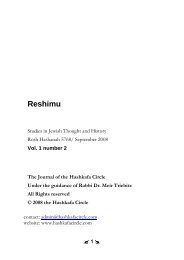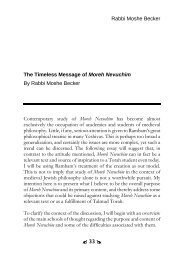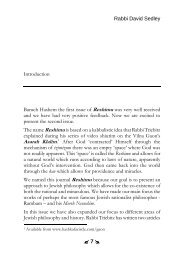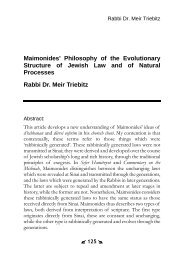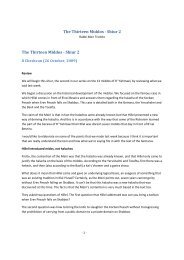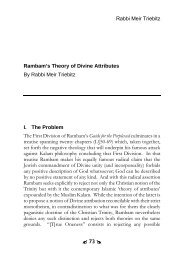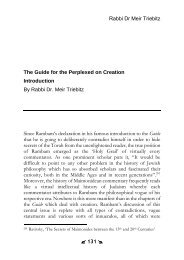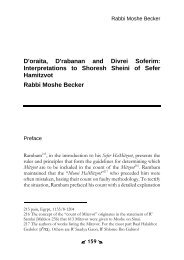Reshimu_3_journal_no.. - Hashkafa Circle
Reshimu_3_journal_no.. - Hashkafa Circle
Reshimu_3_journal_no.. - Hashkafa Circle
Create successful ePaper yourself
Turn your PDF publications into a flip-book with our unique Google optimized e-Paper software.
Rabbi Moshe Becker<br />
brought about the compilation of the Talmud. He had stated that the<br />
generations of Rava and Abaye as well as R’ Ashi were periods of<br />
relative calm and peace for the Jews; this context enabled the scholars<br />
to focus their energies on such a major project as the Talmud.<br />
Perhaps the most important factor, according to Halevy, was the<br />
existence of a single unified academy as the central Torah authority<br />
of the generation – in the first case, Pumbedita; in the second, Sura 67 ,<br />
and in the case of the Savoraim, Neharda’a. The Talmud, or any part<br />
of it, could <strong>no</strong>t have been compiled, and certainly would <strong>no</strong>t be<br />
considered authoritative, if the leading scholars of the generation had<br />
been scattered through several different centers of learning. The<br />
third generation of Savoraim was the last period to see the existence<br />
of one such central academy, and therefore was the latest possible<br />
time that any new parts could have been added to the Talmud.<br />
The final stage of editing by the Savoraim – the third stratum of the<br />
Talmud - culminated with a consensus of the entire leadership 68 that<br />
<strong>no</strong> further additions would be made to the Talmud. R’ Sherira Gaon<br />
calls these events “istayim talmuda” – “the completion of the<br />
Talmud” 69 .<br />
VI. Summary<br />
To summarize, the Talmud developed in the following stages: Abaye<br />
and Rava, the leaders of the fourth generation of Amoraim, collected<br />
all the material that comprised the Oral Tradition, in the form of<br />
reports from their colleagues regarding the traditions they received<br />
along with discussions about these traditions. In these discussions,<br />
positions were often challenged or supported; sometimes resulting in<br />
the rejection of a given opinion, in other cases forcing a resolution.<br />
All this “shakla ve-tarya” – “give and take”, or exchange of ideas, was<br />
67 See III, p. 27.<br />
68 Approximately at the end of the 5 th century.<br />
69 III, p. 26<br />
31



